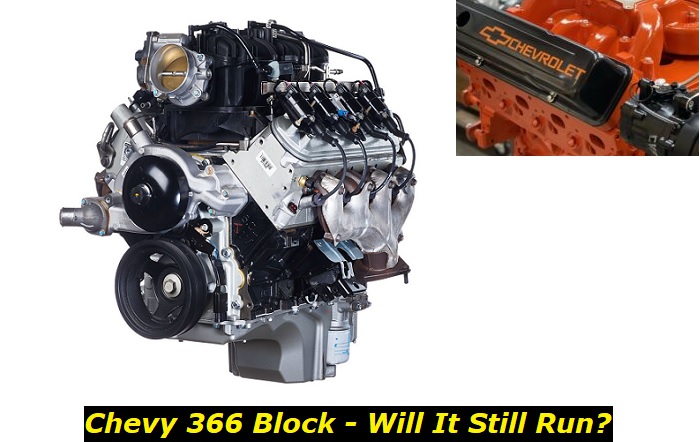Whether it is your first time or not rebuilding an engine, disassembling and building an old engine block would take tremendous effort and time to make it work.
Especially for an old-heavy engine like the Chevy 366 block, the first question that will come to your mind is, Will it all be worth it?
The monstrous beast is known for being a tall deck engine of 0.4 inches. The Chevy 366, with tall pistons and a heavy crank, is also one of the oldest blocks Chevrolet has made for its pickup trucks. Now, this big engine has gained a lot of opinions from engine builders. The recommendations differ on whether installing it as a whole with its still working components would be worth the effort or whether it would be wiser to empty the whole block and fill it with better components.

Key features and my opinion about the engine
- Production years:1960s-2004
- Average lifespan of 366:500,000-650,000 miles
- Fuel supply type:carburetor
- Power range:230-275 hp
- Fuel efficiency:awful
- Engine block material:cast-iron
- Engine reliability score:high
- The most common problems:oil pump problems, carburetor issues, low fuel efficiency, lots of minor problems.
What Do You Need to Know Chevy 366?
GM produced the Chevy 366 around the 1960s until the early 2000s. They built it for medium-built pick-up trucks and school buses.
It was an old cast-iron block, and its cylinder head was aluminum. It has 6.0 liters displacement or 366 cubic inches.
With pistons having a 9.4-to-1 compression ratio, the block utilizes eight cylinders with heads made of aluminum. Each cylinder contains two valves totaling 16 valves.
In terms of performance, the block produces a maximum of 300 hp at 4,400 RPM and reaches 360 ft-lbs peak torque at 4,000 RPM. However, the actual performance specification is lower since the block is old. You might be able to run it a 175 to 225 hp. And going over 4400 RPM could lead you to run with intermittent power.
The Good
- High torque
Looking at its peak torque, you know this truck got a mad strength carrying heavy loads. Using this engine would be a good tower at a standstill. This pickup truck has a maximum towing capacity of up to 10,500 lbs.
- Low RPM
Ideally, trucks should have more power and lower RPM. This figure means it will require less twisting force to move. Fewer revolutions would burn less fuel. Other than that, the lower revolutions mean moving parts would experience less friction.
.
Problems with a Chevy 366 Big Block
- Heavy crank, pistons, and rods
The entire block of Chevy 366 is about 700 lbs of added weight to your truck. Solid cast iron, including the heavy crank, pistons, and rods, stresses the entire crankshaft, making it hard to rotate. The engine is old. And it could mean adding more effort to balance the crankshaft while rotating.
It can also limit reaching the maximum RPM. Additionally, the added weight stresses the piston bore, rod bearings, and rods, which could wear out eventually. Aside from that, these heavy-duty pistons will require more clearance for cylinder pressure and heat released on huge turbos. This extra pressure and weight add stress to each part while they are functioning.
- Hard, not starting, and power loss
A lot of owners have been reporting hard starting and intermittent power issues with the 366 blocks A lot of owners have been reporting hard starting and intermittent power issues with the 366 blocks placed on their trucks.
Some of them reported being able to run the truck smoothly. After some time of turning it off, their vehicle will not start again. And after trying a few more times, the 366 blocks would start, but later on, backfire through the carburetor. When there is more air and fuel is short, this mixture backfires or explodes in the intake manifold and goes out through the carburetor.
More cases have issues where starting is a problem even with a working fuel pump, new cap, coil, caps, or rotor. These cases would have a smooth running 366 at first and would barely show signs of starting. A lot of these cases arise from the faulty ignition module.
The ignition module controls the function of spark plugs and timing. In this case, where the truck won't initiate a spark, you may probably have a bad ignition module. You can easily find out if your vehicle vibrates when pressing the pedal. Your truck could shut off suddenly if there's a temperature rise. You will notice this temperature issue when it starts again after the engine has cooled down.
Failure to start could also mean power issues. So better check your battery and the wires. But at most times, the reason why a 366 engine refuses to start is because of a bad ignition module.
- Small bore, Tall Pistons, and Long stroke
The small bore of a 366 is a disadvantage to having tall pistons and long strokes. It has a 4.0" x 3.62" bore and stroke. The small bore creates a little space to initiate valve openings. Therefore, the machine can accommodate less fuel-air mixture, resulting in less power. Technically, GM has geared 366 to create less RPM, which is ideal for trucks.
But that's not the only case. The 366 small bores produce cylinder heat that is not favorable for the piston holes. With this high temperature created during long strokes, this small bore cannot balance the heat it is getting, resulting in many issues like detonation and melting of piston holes.
- Runs slow
You cannot drive a 366 at more than its maximum RPM, or you will be putting more stress on its crankshafts and pistons. The 366 is limited to its capacity of 300 hp at 4400 RPM. Go over that, and you will surely begin having starting issues.
You can only run it like a dog, and it's limited to that capacity.
- Parts Replacement
If there's any more useful part on a 366 block, that would be the steel crankshaft. You can take it and create a 454 or 427 block. Boring 366 larger would create thinner walls, which would break easily. You can keep the push rods, crankshaft, flywheel, and balancer.
Although spending on a 366 may not be worth it. You'll need piston rings, rectangular port heads, a carb measuring about 850 cfm, a high-pressure oil pump, 1.8 roller rockers, port match spacers and intake, a victor intake manifold, and an 8-quart oil pan. Do your research before spending on any, and think twice before building.
- Not pumping oil
Here's what happens on a 366 when pumping oil. Pushrods put pressure on oil. These oils are essential for the crankshaft to move the camshaft. It is also essential for the camshaft to operate the distributor that's driving the oil pump. The oil is also significant to mechanical lifters and hydraulic lifters. These lifters push the rods up and down to any parts that move in the engine, including the rocker arms and valve guides.
However, when it fails to pump oil, something blocks the way from the crankshaft to the littlest parts of the engine. If it is not due to blockage, there could be broken camshaft bearings or pivot arms.
366 is known for eating and jamming push rods and valves. The rocker ends would find ways out of its line, pushing the pressure on the valve stem until it breaks. And because of this, the oil wouldn't pump out. We've seen a lot of reports where push rods get stuck on bores.
- 366 TBI Fuel problems
Throttle Body Injection (TBI) is a phased-out technology in the 80s that lasted until the 90s when the fuel injections system utilizes one or two fuel injectors on top of the throttle body. These injectors would deliver fuel above the throttle plates into the air. It will produce a fuel-air mixture that will get into the intake manifold and spread to each cylinder.
A lot of users with Chevy 366 engines with TBI reported having a smooth crank but felt less pressure. Most cases happen when pressing the pedal, and it felt like there is little to no pressure. The worst scenario is having the engine stalled while running the engine. And even with newly replaced parts, fuel filters, plugs, and wires, there seems to be weak fuel.
Some 366 would run smoothly with low temperatures and stop again at high temperatures.
Good thing this technology is a bit newer, and the Electronic Control Module (ECM) can troubleshoot for itself. However, with an old block engine, the technology may come incompatible and lead to more sensor failures.
Will This Old 366 Block Still Run?
With our expertise and experience with many engine blocks, we can say that the Chevy 366 still works but runs like a dog. In all honesty, this beast could run for life and still be intact. However, due to old age, its technology may not fit the demanding functionality, even for a pick-up truck. This engine is solid heavy, weighing 600 to 800 lbs. Such weight is not a joke to add to your rod.
The major turn-off would be its small bores that cannot take much fuel-air mixture to turn into power. Yup! The engine works great for towers or dumpsters. But if you're going to spend money, better upgrade the 366 with larger bores.
About the authors
The CarAraC research team is composed of seasoned auto mechanics and automotive industry professionals, including individuals with advanced degrees and certifications in their field. Our team members boast prestigious credentials, reflecting their extensive knowledge and skills. These qualifications include: IMI: Institute of the Motor Industry, ASE-Certified Master Automobile Technicians; Coventry University, Graduate of MA in Automotive Journalism; Politecnico di Torino, Italy, MS Automotive Engineering; Ss. Cyril and Methodius University in Skopje, Mechanical University in Skopje; TOC Automotive College; DHA Suffa University, Department of Mechanical Engineering






Add comment